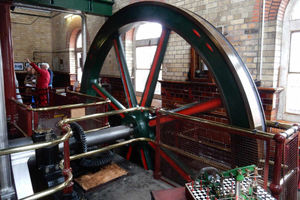Phil Gillam: Something to get all steamed up about
My love of steam railways, Victoriana and bits of old machinery is purely romantic.

I have no particular interest in wheel arrangements, horsepower, valves, pistons, cylinders, blast pipes, couplings, boilers, water compartments, coal bunkers, grates, leaf springs, connecting rods, brake shoes, throttles and smoke-stacks.
But I do love the noise that railway locomotives make, and the lovely smell of the steam.
And the grace of an engine's movements.
And the history of it all.
It is so very romantic.
I'm crazy about the way in which the railway lines snake through our countryside; the bridges, the tunnels, the signal boxes, the stations.
Actually anything to do with steam and the Victorians will win my attention.
So I popped along on Sunday afternoon to see a Shrewsbury attraction that brings together steam, Victorian elegance and old machinery.
Coleham Pumping Station may not have any direct connection with the railways but, naturally enough, it attracts and fascinates the same type of people who would happily spend a day on, for example, the wonderful Severn Valley Railway, just looking at engines and rolling stock and station buildings – and just breathing in the atmosphere.
I was very pleased to see that the pumping station – open on special days throughout the year – had drawn a reasonable crowd.
This, by the way, was the same weekend as Lord Hill's Column (another jewel in Shrewsbury's crown) was attracting crowds keen to climb the monument for magnificent views of the town.
Okay, the pumping station in Coleham may not be on everyone's list of 'must-see' attractions, but it is utterly charming, and – like so many of these places – largely dependent on the love and dedication of volunteers.
And there was plenty to see: not just the pumping engine itself in action, but a couple of model railways, a beautiful display of 1960s toy cars, and various bits of ancient machinery and other exhibits.
Knowledgeable enthusiasts were on hand to explain how the machines worked and shed light on the history of the place.
It all reminded me that when we were kids, steam engines were always a major feature of our family holidays in Wales.
If we were in mid-Wales we'd visit the Fairbourne Railway or the Vale of Rheidol Railway that runs from Aberystwyth or the Talyllyn Railway that runs from Towyn. If we were closer to Porthmadog it would be the Ffestiniog.
And my little brother and I would collect all the badges and souvenir pencil sharpeners, and we'd love every minute of travelling on these historic lines.
Ah - happy days!
But back to Coleham Pumping Station …
For those who don't know it, the building itself resembles a Victorian chapel. Built around 1900, the structure houses two massive steam-driven beam engines, and these were used to pump sewage as part of Shrewsbury's then-new sewerage system.
The coal-fired boilers drove the beam engines that operated the pumps until 1970. After that date, ownership of the building, machinery and grounds was transferred to Shrewsbury and Atcham Council to ensure the history and machinery was preserved for all to see.
Today, the museum comprises the pumping station buildings that are listed with English Heritage as being of architectural importance, and the in-situ beam engines and other items belonging to the Shrewsbury Steam Trust. The pumping station is owned by Shrewsbury Museums Service and is opened to the public on selected dates.
You can find out lots more by visiting its website: colehampumpingstation.co.uk





